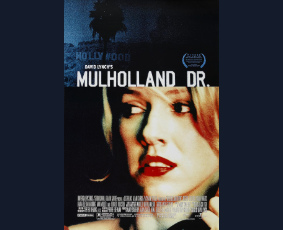Mulholland Drive, U.S./France 2001. Directed and written by David Lynch.
Bambi Theater, Row 1, Seat 6. 4K Restoration. Original version.
(This post also appears at my Letterboxd account.)
The microcosmos that is David Lynch’s 2001 Mulholland Drive is structured after the logic of dreams. Everything in it is constrained by it. Its narrative and cinematographic properties reflect, or are at least reminiscent of, the psychoanalytical and linguistic or rhetorical properties of dreams as explored by Freud and particularly Lacan. Nothing is ever complete or completable; nothing permanent, least of all identities; nothing comfortably readable as an Aristotelian beginning, middle, or end.
The movie’s narrative arc develops less along events than along disturbances. These disturbances cause circumstances and characters to shift, to loop, or to take shortcuts, sometimes abruptly, sometimes imperceptibly, but almost always in intuitively unwelcome ways. The shifts are frightening in their inexplicability; the loops fail to return to their exact starting points; and the shortcuts lead to places that do resemble the original destination, but in an uncanny valley kind of way: similar enough to appear as a continuation, but different enough to evoke the feeling of a terrible loss, the disappearance of something momentously valuable that cannot be retrieved.
As so often in Lynch’s movies, there’s no sense of “period” in Mulholland Drive. The dream world is all-encompassing, and it assembles and manipulates times, events, and identities along the constraints of its structural logic that is always inscrutable and always true. There is no waking up. There is only the dream, and none of the things that happen—for the audience the things happen in earlier or later parts of the movie, but inside it, there are no such things as earlier or later parts—have the right of way, are “more real” than any of the other things that happen. Hollywood manufactures dreams, and that’s certainly a major motif. But here, the movie is itself a dream machine that replicates the conditions of its own actuality. Which it does with a twist—while it is full of unforgettable scenes, these are not spots on a Syd Field diagram. Instead, they appear as fragments that might or might not relate to each other, like recollected fragments that might or might not belong to the same dream. In this case, we think they belong to the same dream because they belong to the same movie with the same actors in the same setting, but how can we be sure.
Watts and Harring are incredible. Cinematography, music, sound design, and editing are stunning. Technically and artistically, there’s so much to discover—the disturbing, subtle shot/reverse shot camera movements in the first diner scene alone are worth an entire treatise. And, as mentioned, the movie is also a commentary on the Hollywood dream machine, and especially on the relentless misogyny women face on the yellow brick boulevard of broken dreams. But all that gets you only so far.
Mulholland Drive can’t be rationally accessed and analytically exhausted by watching and re-watching it often enough. In both the original Wizard of Oz and the original Peter and Wendy, notwithstanding Disney’s vigorously laundered versions, all the places and events are equally real inside their respective fictional worlds. In Mulholland Drive, none of the places and events are real inside its fictional world. But that doesn’t mean that the dream itself isn’t real, or that its places and events don’t relate to each other and to the waking world in profound ways. It is, and they do.
Roger Ebert, I think, nailed it:
The way you know the movie is over is that it ends. And then you tell a friend, “I saw the weirdest movie last night.” Just like you tell them you had the weirdest dream.
Addendum
Just found Kali Wallace’s terrific analysis at Reactor (formerly tor.com).
If you have something valuable to add or some interesting point to discuss, I’ll be looking forward to meeting you at Mastodon!

